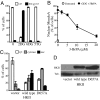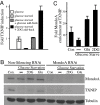Glucose sensing by MondoA:Mlx complexes: a role for hexokinases and direct regulation of thioredoxin-interacting protein expression
- PMID: 18458340
- PMCID: PMC2383952
- DOI: 10.1073/pnas.0712199105
Glucose sensing by MondoA:Mlx complexes: a role for hexokinases and direct regulation of thioredoxin-interacting protein expression
Abstract
Glucose is a fundamental metabolite, yet how cells sense and respond to changes in extracellular glucose concentration is not completely understood. We recently reported that the MondoA:Mlx dimeric transcription factor directly regulates glycolysis. In this article, we consider whether MondoA:Mlx complexes have a broader role in sensing and responding to glucose status. In their latent state, MondoA:Mlx complexes localize to the outer mitochondrial membrane, yet shuttle between the mitochondria and the nucleus. We show that MondoA:Mlx complexes accumulate in the nucleus in response to glucose and 2-deoxyglucose (2-DG). Furthermore, nuclear localization of MondoA:Mlx depends on the enzymatic activity of hexokinases. These enzymes catalyze conversion of glucose to glucose-6-phosphate (G6P), which is the first step in the glycolytic pathway. Together, these findings suggest that MondoA:Mlx monitors intracellular G6P concentration and translocates to the nucleus when levels of this key metabolite increase. Transcriptional profiling experiments demonstrate that MondoA is required for >75% of the 2-DG-induced transcription signature. We identify thioredoxin-interacting protein (TXNIP) as a direct and glucose-regulated MondoA:Mlx transcriptional target. Furthermore, MondoA:Mlx complexes, via their regulation of TXNIP, are potent negative regulators of glucose uptake. These studies suggest a key role for MondoA:Mlx complexes in the adaptive transcriptional response to changes in extracellular glucose concentration and peripheral glucose uptake.
Conflict of interest statement
The authors declare no conflict of interest.
Figures






Similar articles
-
Glucose controls nuclear accumulation, promoter binding, and transcriptional activity of the MondoA-Mlx heterodimer.Mol Cell Biol. 2010 Jun;30(12):2887-95. doi: 10.1128/MCB.01613-09. Epub 2010 Apr 12. Mol Cell Biol. 2010. PMID: 20385767 Free PMC article.
-
MondoA-Mlx transcriptional activity is limited by mTOR-MondoA interaction.Mol Cell Biol. 2015 Jan;35(1):101-10. doi: 10.1128/MCB.00636-14. Epub 2014 Oct 20. Mol Cell Biol. 2015. PMID: 25332233 Free PMC article.
-
Glutamine-dependent anapleurosis dictates glucose uptake and cell growth by regulating MondoA transcriptional activity.Proc Natl Acad Sci U S A. 2009 Sep 1;106(35):14878-83. doi: 10.1073/pnas.0901221106. Epub 2009 Aug 17. Proc Natl Acad Sci U S A. 2009. PMID: 19706488 Free PMC article.
-
Glucose sensing by ChREBP/MondoA-Mlx transcription factors.Semin Cell Dev Biol. 2012 Aug;23(6):640-7. doi: 10.1016/j.semcdb.2012.02.007. Epub 2012 Mar 3. Semin Cell Dev Biol. 2012. PMID: 22406740 Review.
-
Interactions between Myc and MondoA transcription factors in metabolism and tumourigenesis.Br J Cancer. 2015 Dec 1;113(11):1529-33. doi: 10.1038/bjc.2015.360. Epub 2015 Oct 15. Br J Cancer. 2015. PMID: 26469830 Free PMC article. Review.
Cited by
-
Integrative miRNA-mRNA profiling of adipose tissue unravels transcriptional circuits induced by sleep fragmentation.PLoS One. 2012;7(5):e37669. doi: 10.1371/journal.pone.0037669. Epub 2012 May 21. PLoS One. 2012. PMID: 22629440 Free PMC article.
-
Thioredoxin-interacting protein (Txnip) gene expression: sensing oxidative phosphorylation status and glycolytic rate.J Biol Chem. 2010 Aug 13;285(33):25822-30. doi: 10.1074/jbc.M110.108290. Epub 2010 Jun 17. J Biol Chem. 2010. PMID: 20558747 Free PMC article.
-
Normal and Neoplastic Growth Suppression by the Extended Myc Network.Cells. 2022 Feb 21;11(4):747. doi: 10.3390/cells11040747. Cells. 2022. PMID: 35203395 Free PMC article. Review.
-
Physiological and Pathophysiological Roles of Thioredoxin Interacting Protein: A Perspective on Redox Inflammation and Metabolism.Antioxid Redox Signal. 2023 Feb;38(4-6):442-460. doi: 10.1089/ars.2022.0022. Antioxid Redox Signal. 2023. PMID: 35754346 Free PMC article. Review.
-
Nitrosative/oxidative stress conditions regulate thioredoxin-interacting protein (TXNIP) expression and thioredoxin-1 (TRX-1) nuclear localization.PLoS One. 2013 Dec 20;8(12):e84588. doi: 10.1371/journal.pone.0084588. eCollection 2013. PLoS One. 2013. PMID: 24376827 Free PMC article.
References
-
- Pedersen PL. Warburg, me and Hexokinase 2: Multiple discoveries of key molecular events underlying one of cancers' most common phenotypes, the “Warburg Effect”, i.e., elevated glycolysis in the presence of oxygen. J Bionenerg Biomembr. 2007;39:211–222. - PubMed
-
- Freyssenet D. Energy sensing and regulation of gene expression in skeletal muscle. J Appl Physiol. 2007;102:529–540. - PubMed
Publication types
MeSH terms
Substances
Grants and funding
LinkOut - more resources
Full Text Sources
Other Literature Sources
Molecular Biology Databases

